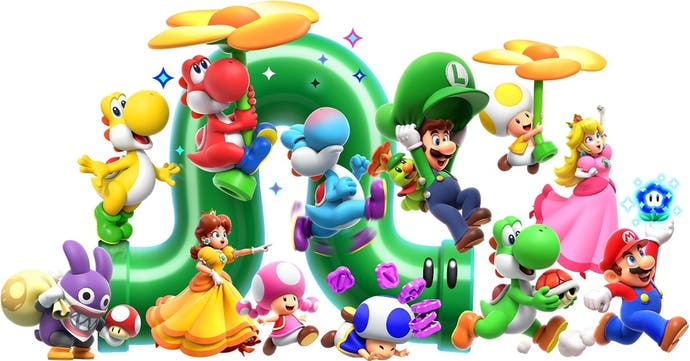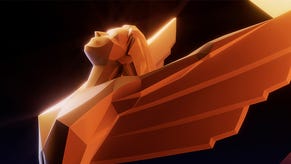Super Mario Bros. Wonder review - kaleidoscopic platforming with ideas to spare
The elephant in the room.
I've been playing Super Mario Bros. Wonder for about a week now, and my head is full of it. What's more - and slightly less convenient - is that my house is full of it too. I'll play and make a note about something incredible but then I'll move on, play somewhere else, make another note, move on again. And all of this brings us today. Let me look around. Stuck to the back of a shirt in the closet is a Post-it with "Platforms of Doom!" written on it. Down by the cactus lamp is a piece of paper talking about Ice Block Tennis. Two pages of my diary are filled with huge letters spelling Young's modulus. What to make of it?
Let's make something of all that first. Platforms of Doom! is my reaction to a level in which the enemies are birds, and the birds shoot projectiles that are dangerous, but which also stick in walls and telescope out to become platforms. A game about jumping and avoiding deadly things is suddenly a game in which you need to avoid deadly things until they suddenly become very useful when it comes to jumping. Mobius Mario! Platforms of Doom!
Ice Block Tennis. This was a discovery from an early level in which you face small enemies with largish boots. It's a frozen level and I was slipping around and having fun and I didn't pay enough attention to those small enemies and their boots at all. That's until they started kicking ice blocks at me, and I discovered I had to knock the ice blocks away or be fatally crushed. Serve and return! Ice Block Tennis!
Young's modulus. Okay, this is a reach and rather pretentious, but I was talking to a developer once about the way they measure the way a balloon, say, deforms when you squeeze it. Surface area and tension and where does everything go and all that jazz. He told me - might have this wrong, it's been a while - that it was all governed by something called Young's modulus. And this is everywhere in Mario Wonder, because it's all about squeezing things, squishing things, popping stuff, bursting stuff. It's Mario but it's also slime YouTube videos, squishee reviews, people mucking about with kinetic sand.
Actually, let's get this out of the way here. Super Mario Wonder is all about a lot of stuff. It's endless variety. It has themes, but lots of themes, too many for any to stand out. Even its organising conceit is actually something that just sends the game exploding outwards in every direction. More than any other Mario game I can think of, this one worships at the church of bits and pieces. Ideas. Scraps of paper. It's glorious. So leap in.
To organise things a little: yes, it's another 2D Mario game, and yes you often run left to right and you bonk mushrooms and collect power-ups. Power-ups are fun here! Alongside Elephant Mario, who is clearly the star, there's the good old fire flower and invincible star, but there's also a new bubble flower, which allows you to trap enemies in bubbles, turning them into coins, and there's a drill-head Mario that allows you to jump inside walls and floors and run around there, avoiding anything on the surface.
But Elephant Mario is the star. What a guy. Big slam, huge weight, a trunk you can use to smash people with or can use to suck up water and spray it out. He's heft, consequence, but with that strange daintiness elephants sometimes seem to suggest, at least in storybooks. Elephant Mario is an object of great poise and I am deeply curious about them. Last night I wondered: what does Elephant Mario look like going through an in-game door? Turns out the developers got there first - of course they did. Elephant Mario getting through a door is sheer drama.
The power-ups are great, but they matter less than you might expect in a game in which every new level is a sort of power-up. Mario's off to the Flower Kingdom. This means flowers you can ping to open stuff out in levels, like coins and platforms. It means a new currency, Flower Coins, which are little purple things scattered around each level and three big things in each level you want to collect. It means flowers that talk to you as you pass - a kind of Mario Chorus that I thought would be annoying, but which is actually charming. It also means wilting flowers for your Elephant Mario trunk to water, and huge spinning heads of petals to lift you across gaps in the overworld map.
All of that, fine, but it also means what I call Flower Events, but which are actually called Wonder Flowers. They're the organising principle I mentioned above - the one that does the opposite of organising.

Where to start with this? Okay. Each completed level here grants you a Wonder Seed, and collecting Wonder Seeds allows you to progress through the overworld map and reach new lands, which in turn have new colours of Wonder Seed to collect there. Repeat until Bowser. You generally get a Wonder Seed for completing a level. Fine. But often, levels have two Wonder Seeds you can get, and you get the other one by successfully completing - or however you want to phrase it: successfully engaging with - the Wonder Flower.
The Wonder Flower (Event) has two steps to it. The first is that as you traverse the level, with all this other Mario stuff erupting around you, you have to be able to see through all that clutter and find the Wonder Flower that triggers the Event. It will float in the air surrounded by a little migraine aura when you find it, but maybe it's hiding. Maybe it's trapped in a block somewhere. Maybe you need to trigger a few other bits of business in order to coax it out. Maybe it's buried in the ground or carried by an enemy.
That is the first step. Find the Flower and trigger it. And the second step? The second step is that something will happen. And it could pretty much be anything.
Often, what happens is a kind of challenge that you have to survive, and if you survive you can grab the hidden Wonder Seed and then beat it to the traditional level exit. So maybe something big starts to chase you! Maybe invulnerability stars start raining down and the speed cranks up!
Those are pretty tame examples, but I don't want to spoil too much more, because the Wonder Flower almost never plays by the rules, and in breaking the rules you get real surprises. In fact, if I were to just start listing these things, I'd sound like one of those mountaineers up high on a peak without enough oxygen, trapped in snow and describing a particularly poignant hallucination.
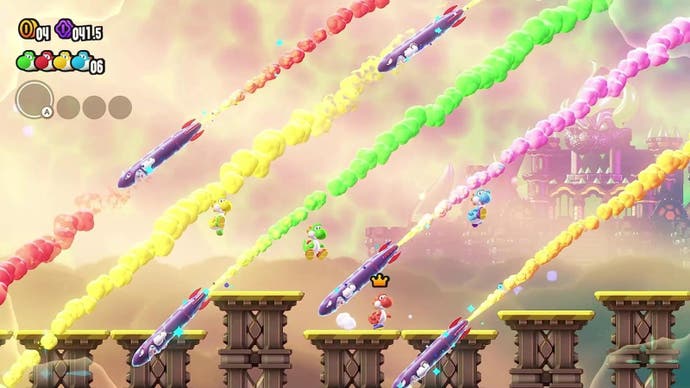
If there's a certain high altitude mindset to this game, I can at least tell you about one of these events. So again, Mario Wonder is 2D Mario in principle. Start at the left, head to the right, stomp stuff and move on. But one early Wonder Flower transformed all of that and for a few giddy minutes I was working my way down through a maze of ice while a massive platform stomped overhead. It was Mr Driller in the middle of Mario! I died a few times just because I was taking the transition in.
Even that's a pretty vanilla outing by the standards of the game. I've got more of this stuff written down, but this isn't the place for it. The embargo is strict, and these Wonder Flower events are so creative and unexpected and I don't want to ruin anything. And I also can't read my own handwriting.
Anyway, if Mario Wonder has a central conceit it really is this: halfway through most levels you find a trigger point that makes the game go completely wild. Strange idea for a Mario game perhaps, but I probably don't need to tell you that these are strange times we're living through. It works here for the same reason that the rest of Mario Wonder works by just pulling every conceivable idea together. It works because of what Dorothy Parker referred to as the disciplined eye and the wild mind. (She was talking about Mario 3.) Mario Wonder throws in bizarre ideas but it always absolutely nails the implementation. I don't really need to tell you this, do I? It all just works.
I am still trying to work out what this means, what impact the Wonder Flowers have on the game itself. Is this a Mario game that offers secrets that are so delightful, but which are so memorable and funny that they stand in for replayability? Is it a game that you enjoy once, twice, and then shelve? I suspect not, because of the sheer density of secrets, and the sheer number of reasons to replay a level - to look for exits, to hunt for surprise moments, to revel in a one-shot character or silly bit of business that is dropped in and then never repeated.
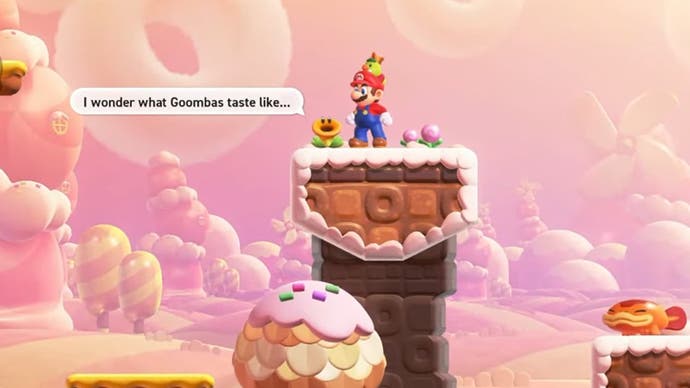
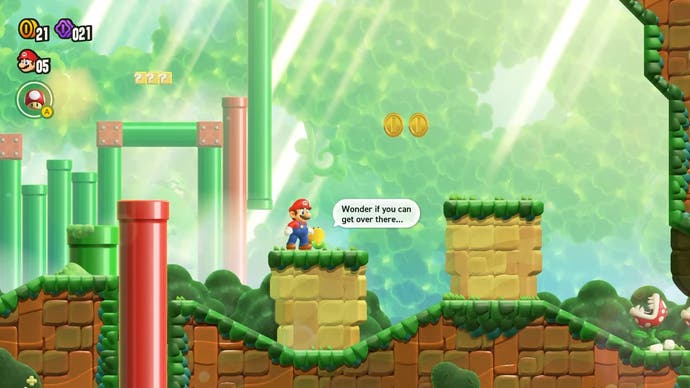
And I say this because, remember, as much as Mario Wonder has those Wonder Flower set-pieces, it just also has a lot of ideas. Pretty much every level here has a one-shot conceit that exists outside of the Flower Event stuff. One will have needle-nosed birds that dive at you. Another will have a new kind of enemy that takes the form of a platform that slams down on you from above but may also be able to lift you to handy places. Another will have gas bag balloon animals that make for uneasy allies. Another will force you to learn how to make use of sentient boulders. Mario Wonder has no shortages of ideas.
Throw in bosses - bit of a letdown, but only because every level feels like a boss fight in a way, with its set-pieces, its staging, its multi-wave inventiveness. Throw in an overworld that is wonderfully rich and colourful, with lots of strange connections to uncover between one spot and the next. Throw in badges, which - okay, I'm really not sure what badges are for, in the minds of the designers at least. They're collectables you find and can have equipped - only one at a time. They're partly a way of making the game a little more forgiving. One badge will allow you to fall off the screen once a level and return safely, say. And they're partly a way of breaking up Mario's fearsome moveset and making it manageable, a series of choices. So you might say, do I want the Yoshi flutter jump, or do I want to be able to squat and then jump extra high? Do I want to be able to swim really well or have a cap that works as a parachute? There are badges for all of these. Then there's a badge for finding secrets - it acts as a kind of radar. And there's my favourite badge, which I still can't really believe exists. It's a grappling hook. Use the badge and Mario gets a piranha creeper grappling hook. You get a bit of Just Cause in the middle of Mario. And it works. I am still getting over it.
All of these badges change the ways that levels work and the options you find in them. And then the levels keep coming up with new forms that turn things on their head. Throw in a large playable cast - Yoshis and Nabbits don't take damage from enemies but can't equip power-ups; Mario has a new voice actor but still pretty much sounded like Mario to me - and an art style that delivers that rosy 2D Mario from the cover of Super Mario 3, but then drifts outwards into everything from psychedelia to the judicious use of newspaper halftone. Throw in multiplayer: it's tense roguelike fun with two, and absolute mindless carnage with four.
It's a rush. Whenever I tell someone I'm playing the new Mario, they ask what the angle is. Is it space, like Galaxy? Vacations like Sunshine? Is it retro stuff like New Super Mario Bros? Is it coins like New Super Mario Bros 2? Is it just really, really hardcore, like New Super Mario Bros U?
The answer, I think, is that there is no one angle. There's elephants and flowers and that hidden event that splits every level in half, but none of those these add up to an angle. In truth, the angle here is that every level is its own angle, and each angle has these little sub-angels, throwaway gimmicks, one-shot animations, bespoke enemies. They called it Super Mario Bros. Wonder. They could just as easily have called it Super Mario Bros. Imagination. Jeepers.
A copy of Super Mario Bros. Wonder was provided for review by Nintendo.
